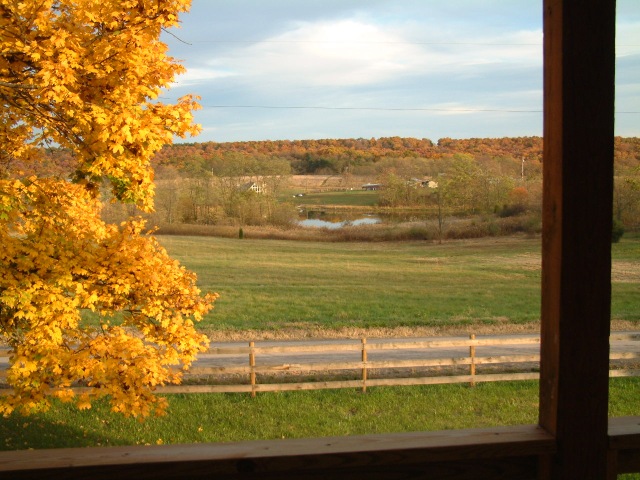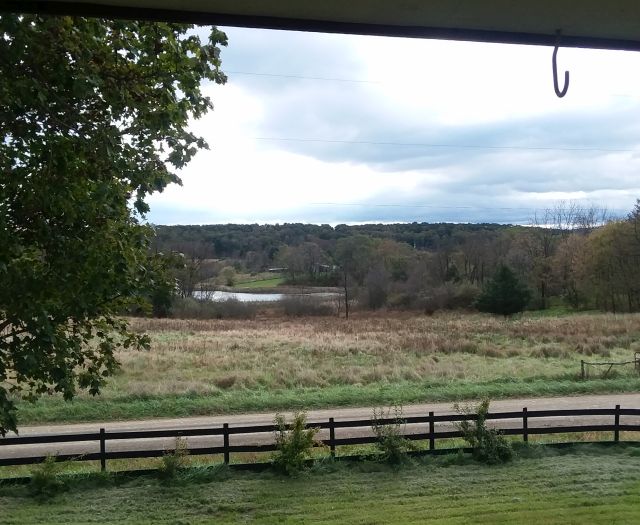Podcast: Play in new window | Download
Subscribe: RSS

The view from my deck (in West Virginia) in mid-October, 2007.

The view from my deck in mid-October 2018. Notice anything?
If you Google “fall foliage 2018,” you will be deluged with Chamber-of-Commerce rantings and tour-operator ravings about the glories of fall and the many opportunities for the well-heeled tourist to revel in it all — for a suitable fee, of course. There’s big money in leaf-peeping, and no money to be made at all from observing that the leaf emperor does not have any clothes on. Well, he does, but they are looking very drab.
But if you drill down into the Google pages (“54,400,00o results in 0.41 seconds”) — it took me about half an hour — you will find a few pieces of actual journalism:
- “Will colorful fall foliage be a no show this year? Sadly, it’s possible.” The Allentown, Pennsylvania, Morning Call.
- “‘We’ve Never Seen Anything Like This’: Fall foliage is still missing in action across the Mid-Atlantic.” The Washington Post
- “Fall foliage season in Pennsylvania: Will it ever get here?” Wild About PA.
Sadly, even the few people who are writing about the problem are not writing about the problem. When they have recognized that the fall colors actually suck, the immediately find a long list of don’t-you-worry causes: it rained too much (or to little) this year, it got too cold too early, or not cold enough too late. For a complete list of excuses, see the piece I wrote about this five years ago: Falling Colors: The Long Agony of Trees.
The reality has nothing to do with a glitch in the rainfall or a disparity in the temperatures. The bad news is that the trees are dying. The good news is that they are dying slowly enough that smart people could do something about it. The bad news is that almost all of them are dying, and have been for years.
Don’t take my word for it. Step out your front door and look at the trees. Look closely, at any time of year, in any part of the United States, and you will see signs of serious sickness. That’s what I did to take the two pictures at the top of this article, one in mid-October of 2007 and the other in mid-October of 2018. And these changes, from Technicolor to virtually brown-and-white, have been progressive over the years and not variable from year to year.
[My go-to source on this subject used to be Gail Zawacki, who wrote passionately and well about it on her blog Wit’s End, but alas she has not written at all this year, and very little the year before.]
It is fairly well known that trees all over the planet are increasingly stressed by warming temperatures, by the flourishing and poleward movement of hot-weather insects, and by increasingly savage storms. So, yes, climate change is an actor. But in this case it is in a supporting role. The killer is ground-level ozone. And the irony is that for decades, while we have been trumpeting our success in damping down ozone levels in polluted cities, ozone concentrations have relentlessly increased everywhere in the countryside.
Ozone in the stratosphere shields the earth and its inhabitants from harmful solar radiation, but at ground level, in very low concentrations, ozone kills people and plants. It paralyzes the stomata in tree leaves that control the intake and release of water. This among other things causes early leaf drop, without the usual color changes. It also weakens the tree to other threats, and occasionally causes so much unneeded water to be taken up and released by the trees that surrounding areas go into drought.
The annual display of vibrant colors displayed by the trees of our world is not put on for our entertainment, or for the profits of the tourist industry. It is a part of the natural order that is slowly disappearing. The absence of those colors is a flag of distress, waving in our faces, to which we are all but oblivious.
We have met the oblivious and they are us.
https://www.theguardian.com/environment/2018/oct/09/tipping-points-could-exacerbate-climate-crisis-scientists-fear
Tom, those are fairly dismal pictures, a decade makes it obvious – yes the trees are dying. They are dying everywhere. I am familiar with Gail’s work. I have a rural property with native forests and have spent the best part of a decade trying to plant rare and endangered trees for all the reasons you have outlined. I cannot attribute all the deterioration to Ozone alone but I do concede that is a problem and worse at mid latitudes around the globe where prevailing winds tend to concentrate it as well (which is about where I am in the Southern Hemisphere).
We have failed to understand the complexity of trees as a living organisms but viewed them only as a resource to be plundered, an inconveniance if they mess up the place or fall over or get in the road of something we want to do. Trees are the givers of iife, shelter, food and healthy soils and home to myriads of organisms, small, large and some very complex indeed. They have been around since the dinosaurs and some even manage to live thousands of years, many in the hundreds of years. The damage we have done to them in the past several thousand years is phenomenal. We also fail to see that the ones we have are the grand survivors (singly or in groups) but now they are starting to go unable to cope with toxic compounds such as Ozone, overdoses of nitrogenous fertilisers, erratic seasons and erratic rainfall. Finally trees were the great moderators, tempering our climate and all living things, as they go so goes life on earth, it is that simple.
Even our hardy eucalypts here in Oz are slowly dying (a mysterious disease undiagnosed called dieback), we have lost close to 15% of the forest on our land and the local district is the same. It is without a doubt the most distressing thing you can imagine and the most frightening aspect of the end of the anthropocene.
Yes it is, especially for those of us who tend to smugness because we are far from the rising seas and the spreading deserts and the hurricane landfalls — and then we find out about this. Thanks, if that’s the right word, for the additional corroboration.
I’ve learned a great deal from this article, and from the comments. I didn’t know it was quite this bad. I’m not a big fan of Autumn – don’t like harsh light and brite colors – so I was pleased with the ongoing greenery here in the Midwest. Not any more!
Ignorance is bliss I guess…’Bliss’ – that’s a commodity that’s hard to come by these days.
I live in the northern Midwest myself. It hasn’t been an excessively warm autumn, so I was wondering why the leaves just aren’t changing colors, and it’s now the seasonal month of mid-autumn!
Where I live (southwestern Oregon, U.S.) the area forms the cusp between northern California’s hot and dry Pine/Oak Savannah and the wetter/cooler area to the North that supports Douglas Fir, Alder and other damp area species. Hence we have until recently had a mixture of the two distinct flora types. Now, however, we’re seeing a general die-off of the wet area species (D. Fir especially) and an influx of more scrub oak, etc. I ascribe this to the advent of climate change which has produced less rain and snowfall and more drought in our area thus stressing the flora and allowing an influx of destructive insects to attack the now-weakened trees. It’s sad to see and probably irreversible.
I live in western New England which, in years past, featured some of the most spectacular fall foliage anywhere. Not anymore. Oh, there are still some stunning individual trees, some beautiful swathes here and there on a hillside but nothing like years past when the entire region just took your breath away in October. Now it’s mostly very muted, lots of early leaf drop. And it’s so apparent that many trees are sick, weak and dying.
I hadn’t know about the ozone pollution factor but am aware that ozone levels in this area (Connecticut River Valley) are very high. Combined with the climate warming and instability it’s a fustercluck of tragic proportion. Don’t it always seem to go that you don’t know what you’ve got til it’s gone…
Thanks for telling it like it is. No matter how painful, I’d rather know the truth.
The pine tree in my yard is dropping green needles instead of brown. Since we have lived here (sixteen years), the fall needles were always brown.
Well Tom, I may be slow sometimes but eventually I get it. In the case of this article’s title it didn’t click until the second time. This is similar to my saying which is “Nature lets us know by whispers. If we don’t listen, then she slaps us up the side of the head”.
Of course, if we don’t get it by that time then measures will be more extreme.